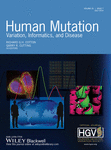Palindrome-Related Mutations in Neurofibromatosis 1: a New Hot-Spot, at PATRR17
Neurofibromatosis 1 (NF1) is an autosomal dominant tumor syndrome. It is caused by germline inactivating mutations in the NF1 gene, which consists of 57 exons encoding the 2818-residue protein neurofibromin. Somatic mutations of the other allele (two-hit mechanism) are involved in many of the clinical features, such as neurofibromas. The >1000 NF1 mutations known thus far are scattered across the gene and are varied, including nonsense and missense mutations, splicing errors, deletions (including whole locus), and insertions. In half of cases, the condition has arisen de novo, which, together with NF1's incidence (1/3000) and extreme allelic heterogeneity, has led to the suggestion that this locus has an unusually high germline (and possibly somatic) mutation rate. However, this phenomenon, and underlying NF1 mutation mechanisms, have not yet been fully characterized.
Previously, several reciprocal translocations were identified in which the chromosome 17 breakpoints all lay in NF1 intron 40, which contains a palindromic AT-rich sequence of 197 bp called PATRR17. PATRR17 has two major forms not affecting gene expression, differing in length by 46 bp, which are likely due to palindrome-mediated deletion at its variable (AT) repeat stretch. In this issue, Hsiao et al. (Hum Mutat 35:891–898, 2014) hypothesized that this region could be mediating deletions or duplications that extended into the NF1 gene, thereby resulting in pathogenic NF1 mutations. Through screening 6,100 NF1 cases, this group found and sequenced the breakpoints of five such deletions and one translocation involving PATRR17, thereby discovering the first intragenic rearrangement hotspot in NF1, narrowed down to a 7-bp region. No duplications were found, but it was proposed that such cases may not have an abnormal phenotype. The translocation breakpoint on the other chromosome was at a palindromic region containing a quadruplex-forming G-rich sequence, also a novel finding. Further, although previous studies had suggested that PATRR17 translocation breakpoints were likely due to replication-independent mechanisms, Hsiao et al. provided novel computational evidence that their six rearrangements are most likely mediated by a replication–dependent mechanism. Therefore, PATRR17-mediated rearrangements likely involve multiple mechanisms. This work adds substantially to our understanding of germline NF1 mutations, though it will be interesting to see if the same mechanisms are at work somatically.




